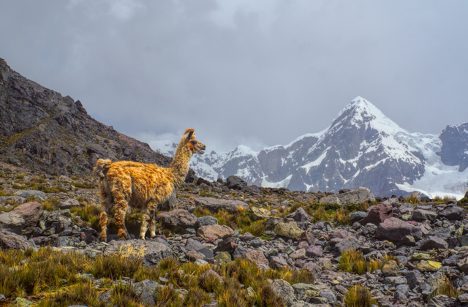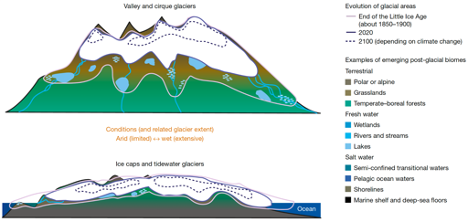Energy Innovation partners with the independent nonprofit Aspen Global Change Institute (AGCI) to provide climate and energy research updates. The research synopsis below comes from AGCI’s Emilio Mateo. A full list of AGCI’s updates is available online.

Mountain glaciers and polar ice caps are experiencing extensive and increasingly fast loss rates as global temperatures warm. The well-documented retreat of mountain glaciers will have severe ecological and societal costs as the shift to a post-glacial landscape represents one of the largest and fastest ongoing ecosystem changes.
A recent report from the Intergovernmental Science-Policy Platform on Biodiversity and Ecosystem Services states that approximately one million plant and animal species are under threat of extinction worldwide due to human-induced climate change.
As new landscapes and ecosystems emerge from the loss of glacier coverage, scientists are trying to understand what the consequences are for biodiversity in these regions, and what can be done to increase the adaptation potential of biodiversity. Emerging research underscores that we are at a critical juncture for decisions to be made about the protection and adaptation of post-glacial ecosystems.

Modeling post-glacial ecosystems
In a recent article published in Nature, J.B. Bosson and a team of French and Swiss researchers modeled future glacier evolution through 2100 (Figure 1). They projected that the global extent of ice-free areas will grow by 149,000 km2 (the area of Nepal) to 339,000 km2 (the area of Finland) by the end of this century.
They also calculated subglacial (below glacier) topography from modeled high-resolution ice thickness, providing information such as terrain slopes as well as where water might accumulate in topographic depressions as ice melts. They then combined this information with mean annual air temperature projections in order to examine future ecological conditions. The study established four habitat categories: extreme (cold and either steep or deep water accumulation), two levels of intermediate (either cold or steep, or cold or deep water accumulation), and mild (either temperate and flat or temperate and shallow water accumulation).
Bosson et al. determined that post-glacial ecosystems will store between only 0.4 percent to 5 percent of the water currently stored in glaciers. Moreover, invertebrates that currently live exclusively on glaciers or in glacial streams, such as glacier ice worms and stoneflies, will continue to lose habitat and may not be able to survive in post-glacial ecosystems.
Biodiversity tradeoffs
While the loss of glaciers poses an existential threat to certain species, this analysis suggests that some of the deglaciated habitats will emerge as “diverse biomes and represent rare pristine terrestrial, marine and freshwater ecosystems when natural areas are globally largely modified or degraded (especially in freshwater and coastal environments).”
Specifically, in regions where mild or intermediate habitat conditions are projected to emerge, such as Iceland, the Andes, and New Zealand, numerous terrestrial and aquatic species should be able to adapt to the new post-glacial ecosystems. In mild habitats, as categorized above, new plant growth may even capture and store significant amounts of carbon through growing biogeochemical processes and biomass (Figure 2).
In order to fully understand the biodiversity tradeoffs in post-glacial habitats, the authors note that their model estimates and the environmental impacts will need to be further explored on a local scale.

Plotting llamas
A closely related article led by Anaïs Zimmer, published in Nature Scientific Reports at the end of September, explored a single post-glacial ecosystem in Peru’s Cordillera Blanca region from 2019 to 2022. The aim of this study, conducted by a multinational team of researchers from the United States, Peru, and France, was to assess whether native llamas influence soils and vegetation following the retreat of the Uruashraju glacier (Figure 3). Taking place 24 to 40 years post-glacierization, this study was set up at the opportune time to measure the changes occurring in this environment. It’s an example of exactly the kind of place-based local research that is required to ground-truth model outputs like those published by Bosson and colleagues.

Within four llama inclusion plots and four control plots, the authors collected soil samples, measured plant diversity and productivity, and sampled llama dung piles (Figure 4). The plots with llamas were shown to have greatly increased soil organic carbon and soil nitrogen, along with a 57 percent increase in vascular plant cover during the final two years studied. In the llama plot, the authors also identified four new species that were not present prior to 2019. Some of these results were attributed to the fact that llamas can carry seeds from lower elevations or other valleys to post-glacial ecosystems, potentially initiating this regrowth.

Following three years of field data collection and statistical analyses, Zimmer and colleagues found that “the presence of llamas had a substantial impact on the primary vegetation succession at the Uruashraju glacier foreland.” In other words, post-glaciated areas where llamas were active on the landscape had significantly more biodiverse plant communities than those without.
In Peru, local communities are beginning to re-introduce llamas and other Andean camelids (vicuña, alpaca, and guanaco) at high elevations, confirming local knowledge of the benefits these mammals can provide. Importantly for similar regions around the world, the study findings provide insight into the possible future management and conservation of these newly exposed post-glacial ecosystems through rewilding interventions of other large mammal species that can play a critical role in the spread and germination of seeds.
Climate adaptation strategies
A review article published in 2022 by Thomas Ranius and colleagues compiled recommendations from 74 research papers for how to adapt current conservation strategies of protected areas, such as wilderness areas and national parks, in the face of climate change. While the article does not focus on post-glacial landscapes, its findings are relevant to glacial areas, most of which are found in protected areas.
The authors found that research conducted in this space produced recommendations that fell mostly into five main categories: “(i) Ensure sufficient connectivity; (ii) Protect climate refugia; (iii) Protect a few large rather than many small areas; (iv) Protect areas predicted to become important for biodiversity in the future; and (v) Complement permanently protected areas with temporary protection.” These recommendations could be applied individually or collectively, depending on the climate adaptation needs at the local scale of each protected area.
When considering these recommendations in the context of a glacial and post-glacial environment, the most important suggestion is to protect areas predicted to become important for biodiversity in the future. The paper recommends extensive monitoring of regions that implement one or more of these recommendations to evaluate their effectiveness and to determine if further climate adaptation strategies are necessary. With post-glacial ecosystems so rapidly expanding in a changing climate, the authors underscore the urgent need for greater research and monitoring of these habitats to help inform conservation decision-making.
Ultimately, local managers of protected areas will need to decide which climate adaptation strategies are best suited for their environments. Locally relevant adaptation strategies, such as the reintroduction of llamas in the Peruvian Andes, helped to boost biodiversity. Elsewhere, the five recommendations from the scientific literature discussed here could be used to protect biodiversity in newly ice-free habitats.
Cumulatively, these articles urge further study and monitoring of current climate adaptation strategies at the base of mountain glaciers. Recent news articles also call for future environmental policies that consider adaptation strategies for both biodiversity loss and climate change together, instead of approaching them separately.
We cannot fully stop glaciers from receding, but through better stewardship of the exposed novel ecosystems, we can help them succeed in being more productive carbon sinks and better habitats for diverse flora and fauna.
Featured research:
Bosson, J.B., Huss, M., Cauvy-Fraunié, S. et al. Future emergence of new ecosystems caused by glacial retreat. Nature 620, 562–569 (2023). https://doi.org/10.1038/s41586-023-06302-2
Ranius, T., Widenfalk, L.A., Seedre, M. et al. Protected area designation and management in a world of climate change: A review of recommendations. Ambio 52, 68–80 (2023). https://doi.org/10.1007/s13280-022-01779-z
Zimmer, A., Beach, T., Riva Regalado, S. et al. Llamas (Llama glama) enhance proglacial ecosystem development in Cordillera Blanca, Peru. Scientific Reports 13, 15936 (2023). https://doi.org/10.1038/s41598-023-41458-x